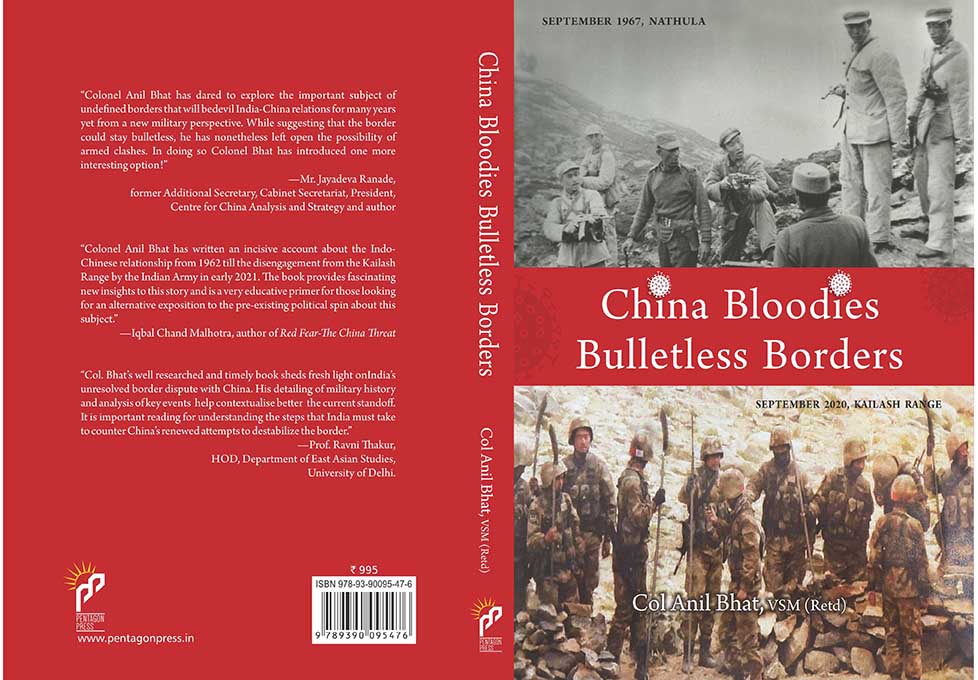Book Name: CHINA BLOODIES BULLETLESS BORDERS
Author: Col Anil Bhat, VSM (Retd)
Pubisher: Pentagon Press
Pages: 243 in hardback
Price: Rs. 995/-
H.E. Mr. Bhagat Singh Koshiari, Governor of Maharashtra, launched a book titled China Bloodies Bulletless Borders, by retired Col Anil Bhat (Pentagon Press), on March 19, 2022, at Raj Bhawan, Mumbai. Also present was Mr. Ashish Shelar, Member, Legislative Assembly, representing Bandra, West, Mumbai, who recommended the book to the Governor for launching it.
The first chapter of the book titled The Runup to the 1962 Sino Indian War begins by clarifying that the so-called India-China border is in fact the India-Tibet border and covers major events and issues that led to that war, which include some disastrous omissions and commissions of Nehru and Krishna Menon, the Dalai Lama’s escape to India and initial smatterings of China’s deviousness.

The second chapter’s title, The Nathula-Chola Skirmishes, which became a Game Changer, says it all. It brings out (a) the decisiveness/assertiveness of India’s then Prime Minister, Indira Gandhi, who sanctioned use of artillery requested for by the Nathula Brigade Commander and thereby turning on its head the flawed China related policy of her father, Nehru and (b) Indian Army’s fighting spirit and capability with partially better arms and equipment, as compared to 1962, which shocked the Chinese enough for them to press for resolving all disputes by discussion and no use of firearms/force.
The third chapter, 1967-2007: Tulung La, Sumdorung Chu, Bulletless Bouts and Dialogue, is all about the problematic process of bullet-less border management by the Indian Army against the PLA, politically indoctrinated by the megalomanic, hegemonic and devious Chinese Communist Party. This entailed a range of actions, from joining hands and stopping/blocking the intruding Chinese troops to grappling/pushing/pulling or at most fisticuffs. Tulung La in Arunachal Pradesh was where PLA killed four Assam Rifles soldiers, in October 1975, notably not by bullets but by torture.
The fourth chapter, 2007-2017: Intrusions Galore and Dra‘goon’ Diplomacy, covers the developments following then BJP MP, Kiren Rijiju, stating in May 2007, that China had moved 20 kms inside Indian territory in Arunachal Pradesh, amounting to 9000 square kilimeters. Also, PLA’s focus was shifting to Eastern Ladakh. A classic case of dra‘goon’ diplomacy was when Xi Jingping was being hosted by Prime Minister Narendra Modi on the banks of the Sabarmati, in September 2014, PLA was intruding into Chumar and Demchok.
The fifth chapter of the book, Doklam, is about how even that crisis was dealt with without firing but with much physical jostling and fisticuffs and finally resolving it at a time that marked fifty years of bulletless border management.
The sixth chapter, Wuhan and Mamallapuram Summits followed by the Wuhan Virus, covers the summits and how-very ironically- the Wuhan Institute of Virology turns out to be the source from where the whole world gets contaminated.
The seventh/last chapter, Galwan and Kailash Range, dwells on how in May 2020, the PLA began what amounted to China’s second aggression (the first being in 1962) across the LAC, drawing blood, ironically again, without firearms but with crude medieval barbaric weapons introduced by it for the first time. Then came PLA’s next stage of upping the ante by killing 20 Indian soldiers of 16 Bihar, at Galwan, including their Commanding Officer. Indian Army’s quick and very fierce response, ironically again without firearms, cost the PLA what was eventually estimated as well over one hundred killed.
There is no doubt that the 1967 skirmishes were the first rude shock to the PLA. Indian Army’s response at Galwan, was a second rude shock and one which prevented it from any further similar misadventures. The third rude shock for the PLA was of Indian Army occupying Kailash Range on the night of 29-30 August 2020. PLA finally broke the no firing protocol 53 years later, on the night of 06-07 September 2020, when its detachment approaching Kailash Range was ‘advised’ by Indian troops to go back. In frustration they fired a few rounds in the air before returning.
The book describes with details and analysis the problematic process of bullet-less border management by the Indian Army against the PLA, politically indoctrinated by the megalomanic, hegemonic and devious Communist Party of China. It is a saga of over half a century of PLA’s intrusions/transgressions on an almost daily basis across a very long disputed border without it deciding/declaring claim lines and constantly shifting goalposts. In 2020, during the pandemic, it committed a second aggression injuring over hundred and killing twenty Indian Army personnel with medieval barbaric weapons and thereby breaking every Sino-Indian peace agreement.
Addressing the gathering just before the Governor at the book-launch function, Mr. Ashih Shelar made some significant points and observations.
H.E. Governor Koshiari, complimenting the author on his research, appreciated Indian Army’s professionalism and restraint in in dealing with Chinese troops without using firearms, expressed deep concern about China’s biological warfare programme and recommended that the book be read widely, particularly by those dealing with China.

The writer is editor WordSword Features. He is also a strategic analyst and former spokesperson, Defence Ministry and Indian Army, and can be contacted at wordsword02@gmail.











